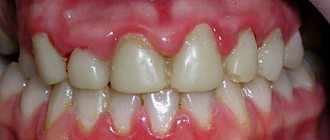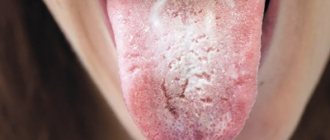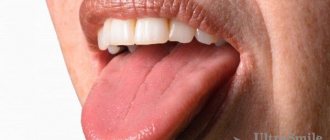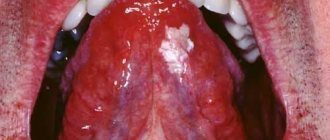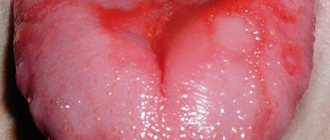Malocclusion
Incorrect bite formation leads to permanent injury to the mucous membranes of the mouth and tongue. As a result, the muscle organ swells and increases in size. Due to constant biting, teeth marks are left on the sides of the tongue.
The disease can be cured only after correcting the malocclusion. To do this, the doctor selects a design to straighten the dentition. For minor violations, patients are prescribed to wear orthodontic plates, trainers, and silicone trays. In case of more serious pathology, the defect is corrected using braces. The course of treatment can take from 3 months to 2 years.
Other dental problems
When teeth imprints constantly appear on the tongue and cheeks, while a person manages to bite and injure the mucous membrane, this can indicate not only malocclusions, but also other dental pathologies:
- incorrectly installed crowns, fillings and dentures,
- presence of chipped and damaged teeth,
- abnormal structure of the temporomandibular joint,
- bruxism,
- lack of teeth,
- anomalies in the growth and eruption of third molars: for example, “eights” can grow into the cheek, cause crowding of the row and provoke bite pathologies.
Folded tongue
This is a congenital anomaly in which the tongue is excised by longitudinal and transverse folds, wavy, uneven at the edges. As a rule, the disease is accompanied by an increase in the size of the organ and its thickening; teeth marks can be seen on the sides. Usually the pathology is asymptomatic and does not cause discomfort; pain and inflammation can appear after infectious diseases, with the development of stomatitis or glossitis.
The folded tongue requires good hygienic care, since bacterial plaque easily accumulates in the cracks and creates a convenient environment for the proliferation of pathogenic bacteria. Such a disease is incurable; therapeutic procedures are necessary only when stomatitis and glossalgia develop.
Why do teeth marks appear on the tongue and what to do about it?
If you notice teeth marks on your tongue, then this symptom should alert you. We must not forget that the tongue is a mirror of the body. It is through this organ that signals about various pathologies and diseases that require treatment can be received. We will talk about the most common of them in our article today.
Liver diseases
In people suffering from serious liver diseases (viral hepatitis, cirrhosis of the liver), the tongue has a characteristic appearance - the mucous membranes are red, hyperemic, the surface is smooth, glossy, the papillae are smoothed. Often such symptoms are accompanied by swelling of the organ and an increase in its size, as a result of which the edges are constantly bitten by the teeth, forming wavy sides.
Among the additional external symptoms, patients note the appearance of spider veins, xanthomatous plaques, and erythema (redness) of the palms on the surface of the skin. Patients complain of pain in the right hypochondrium, nausea, vomiting, indigestion and stool disorders.
The disease must be treated by a general practitioner, infectious disease specialist, surgeon or oncologist.
Localization
Close attention is paid to the site of swelling. The varied nature of the disease harms a specific area of the muscular organ. If the root is affected, problems with the large intestine can be assumed. Pathology in the middle indicates improper functioning of the duodenum or small intestine, as well as the stomach. When imprints of chewing organs are visible on the sides, the patient is advised to balance the diet. More about this.
Along the edges
Is your tongue swollen around the edges? In such a situation, marks from the side teeth are visible on it. This most often occurs when a deficiency of nutrients in the body is diagnosed. Also, the edges are affected when problems with the thyroid gland occur. If water is retained in the body, there will also be dents on the sides of the organ. Most often this is diagnosed in diabetics, with inflammation or enlargement of the liver. It happens that this condition is typical for a diseased spleen, excess weight, and improper digestion.
On one side of the tongue
A symptom such as one-sided swelling due to a certain disease. It can be triggered by various factors: chronic diseases, bacterial or fungal infection, neoplasm, herpes virus and other ailments. It happens that one side swells as a result of injury. This could be a bite, burn, or surgery. Often Quincke's edema or allergies affect a specific area - an area on the right or left side.
Under the tongue
When swelling affects the area under the muscle organ, this most often indicates improper functioning of the salivary glands. Many provoking factors can lead to this condition. Among them are infection, mumps, sand in the salivary glands, HIV, herpes, influenza, poor hygiene, parainfluenza of both types.
Vitamin deficiency
If there is a lack of vitamins B and D in the human body, the surface of the tongue dries out, cracks, becomes inflamed, becomes coated, and bad breath appears.
When an allergic reaction to vitamins occurs, the muscular organ swells, and dents from the teeth are clearly visible on its lateral surfaces. With a lack of vitamin B₃, the organ cracks, painful sensations appear, and a burning sensation occurs while eating. If an infection occurs, an acute inflammatory process develops, purulent ulcers form, and the person’s well-being worsens. To treat the disease, it is necessary to compensate for the lack of vitamins in the body.
Treatment in the clinic
Before prescribing medications and procedures, it is necessary to find out why cracks occur. After this, a plan is drawn up, which may include:
- Treatment of a common disease
- Antifungal medications
- Iron tablets
- Vitamins
- Corticosteroids
- Immunostimulants
- Antihistamines
The surface of the tongue is disinfected with antiseptic solutions. Painkillers are used to reduce pain.
If mechanical injuries occur as a result of unsuccessful prosthetics, it is recommended to replace the structure.
Hypothyroidism
This disease is caused by a malfunction of the thyroid gland. The pathology is manifested by swelling of the tongue with characteristic marks of teeth on its surface. Patients are inactive and find it difficult to talk due to dry mouth. There is a sensation of a foreign object in the mouth, the tongue becomes tangled.
External symptoms of the disease include a yellow tint to the skin, swelling of the face, increased hair loss, deterioration of memory and intellectual abilities, disruption of the digestive tract, and disorders of the genitourinary system. Hypothyroidism is treated by an endocrinologist.
Causes
If we exclude everyday causes associated with mechanical damage to the mucous membrane of the tongue, swelling is almost always a symptom of other diseases. Therefore, you cannot delay visiting a doctor. The most common reasons are:
- Allergic reaction. Swelling can be caused by taking medications or foods that cause allergies. Typically, patients prone to allergies are aware of their problem. If you suspect allergic edema, you should consult a doctor. A severe allergic reaction can cause angioedema or angioedema. This condition develops rapidly, quickly spreading to the lips, cheeks, and larynx. The patient finds it difficult to breathe. In the most severe cases, angioedema can be fatal.
- Mononucleosis. A disease characterized by inflammation of the throat. Swelling of the tongue with mononucleosis is one of the accompanying symptoms.
- Diseases of the gastrointestinal tract. Edema develops against the background of colitis, enterocolitis, peptic ulcer, gastritis and other diseases. This reason is one of the most common.
- Hormonal disorders. For many diseases associated with hormonal imbalances, a swollen tongue is one of the symptoms.
Swelling of the tongue is not always a symptom of other diseases. Swelling often appears for everyday reasons:
- Bite.
- Burn.
- Mechanical damage (dentures, braces, poor-quality fillings, piercings, etc.).
Gastrointestinal diseases
The oral cavity and digestive organs are in direct communication. Diseases of the stomach and intestines cause acidity in the mouth, creating a convenient environment for the proliferation of bacteria. A persistent white or yellow bacterial coating appears on the surface of the tongue and mucous membranes, spots or erosions may form, the organ becomes inflamed and increases in size.
A symptom of the development of gastrointestinal diseases is the root of the tongue coated with plaque.
Peptic ulcers of the stomach, duodenum, duodenitis, dysbacteriosis, gastritis with high acidity, and colitis can cause such symptoms. Additionally, patients are bothered by abdominal pain, nausea, vomiting, heartburn, stool disorders, and flatulence.
To treat the pathology and eliminate plaque on the root of the tongue, you need to consult a gastroenterologist. During therapy, plaque and swelling disappear. If erosions have formed on the mucous membranes, it is necessary to do regular antiseptic mouth rinses with Chlorhexidine, Miramistin or Chlorophyllipt.
Home Remedies
Folk remedies are not able to eliminate the cause of cracks, especially if it is a common disease. In rare cases, the body can defeat a bacterial infection on its own. Therefore, medications from a home medicine cabinet can only be considered auxiliary. These include:
- Gargling with decoctions of sage and chamomile
- Lotions with sea buckthorn or olive oil
- Propolis
- Potato juice applications
Incorrectly selected folk remedies can reduce the effect of drug treatment.
Be sure to consult your doctor.
Nervous system diseases
With disorders of the nervous system, unpleasant painful sensations occur, tingling in the tongue, a disturbing feeling of dry mucous membranes, hyperesthesia, burning, disturbances of taste, diction, swelling and the appearance of bacterial plaque. This disease is called stomalgia, most often it affects women during menopause or after suffering shocks. Symptoms of the disease decrease with eating, especially when eating spicy foods. Unpleasant sensations are localized on the tip and sides of the swollen tongue, its edges are wavy, and dents from the teeth are visible.
The main causes of pathology are recently experienced tragic events in life: the death of relatives, cancer of loved ones, personal problems. Patients are easily excitable, constantly look at their tongue in the mirror, and are pathologically afraid of developing cancer.
Treatment of stomalgia is carried out comprehensively. It includes medication, psychotherapy, physiotherapy, acupuncture, and oral sanitation.
Uneven, wavy edges of the tongue may indicate the development of a serious illness. Therefore, if such a symptom appears, you should consult a dentist and therapist. Timely treatment will help avoid the development of severe complications.




